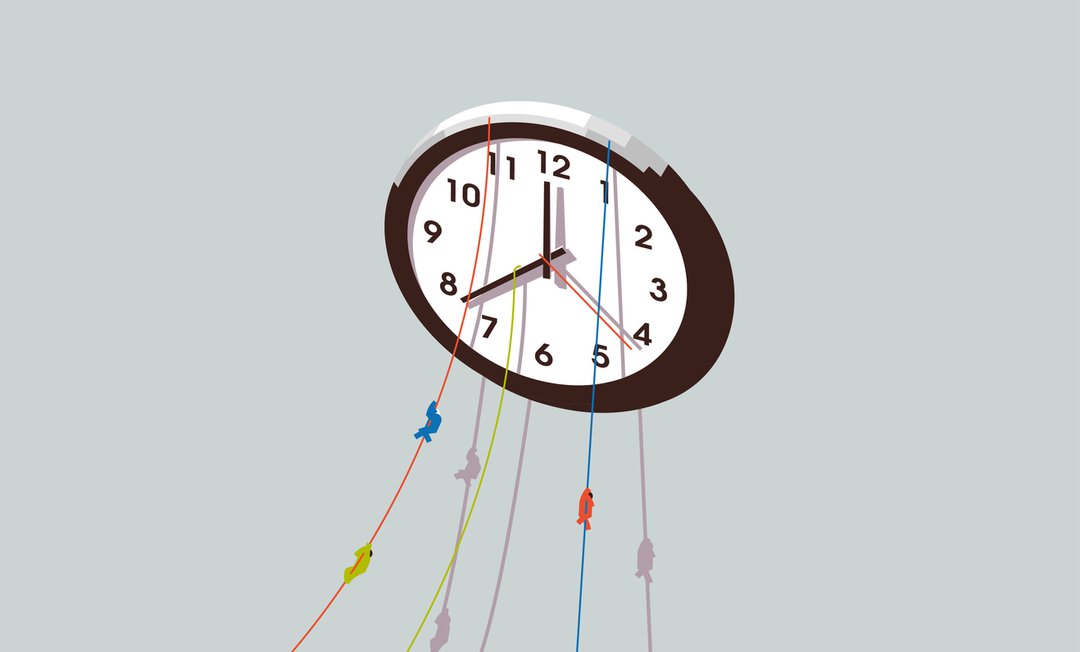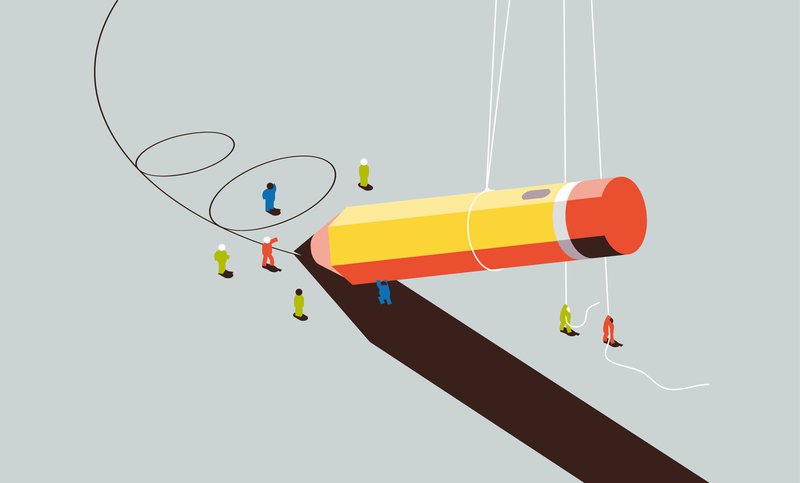
A major source of stress for many is the pervasive feeling that there is never enough time. In response, many of us turn to time management. We try to squeeze hour-long meetings into half-hour sprints by being “more efficient” or we slot smaller tasks into gaps in our calendar to minimize unproductive time. And yet, paradoxically, time management often increases the stress we face instead of reducing it. As we become more efficient, we make room for even more tasks and feel even more pressure. When we are feeling overwhelmed, we are better served by attacking the root causes: the sheer volume of tasks, decisions, and distractions.
The Trap of Time Management
The move to remote work following the onset of the Covid-19 pandemic provided an interesting natural experiment that illustrates the paradox of time management. More than three-quarters of people report that working from home saves them time, typically related to commuting and business travel, and about half of remote workers report that they are more productive.

Despite these self-reported time savings and productivity gains, data from enterprise software firm Atlassian shows that the average workday has expanded by a full 30 minutes globally — the opposite of what we would expect with people using their time more productively. Compounding the issue, the additional 30 minutes of work has come mostly at the expense of what is typically leisure time in the evening.
Time management promises us that if we become more efficient, we can make space to accommodate all of our to-dos comfortably. And yet, time management is like digging a hole at the beach: the bigger the hole, the more water that rushes in to fill it. In a world of potentially infinite demands, freeing up an hour on your calendar is akin to setting off a signal flare announcing your capacity to jump on another project or take on an additional role.
This is not to say that time management has no value. Productivity is important. But in a world where burnout is running rampant, we also need strategies for eliminating volume instead of simply accommodating it. There are three things you can do to escape the trap.
Reduce the Volume of Tasks
To-dos represent an agreement: “I’ll handle the budget update for next week’s meeting,” “I’ll pick up something for dinner on the way home,” or “I’ll send you the updated PowerPoint deck later tonight.”
As soon as an agreement is in place, it begins to create the pressure to deliver. If we have to break or renegotiate the agreement, we add the additional stress of a challenging conversation and the guilt of letting someone down. To reduce the pressure from task volume, hold the line upfront so you aren’t forced to renegotiate later. How you hold the line depends on whether your pile of to-dos tends to grow from tasks you are assigned or from tasks that you choose to take on.
For tasks that are assigned to you, think in terms of priorities not time. When a superior asks you to do something, responding with “I don’t have time for that” may feel too abrupt. Instead, consider asking: “Where would you like me to prioritize this against x, y, and z?” This accomplishes two things. First, the onus for prioritization is placed on the superior, not you. Second, it reframes the exchange from a binary choice to a collaborative discussion about what is most important.
For tasks you are considering adding on yourself, calendar-block first. We often overwhelm ourselves because we are overly optimistic about our capacity. We look at our calendar, see some daylight, and think, “Okay, I can probably get this done for Friday.” And then Friday comes, and — lo and behold — we have to renegotiate.
The challenge is that your calendar usually only shows the claims on your time that involve synchronous work (tasks that you perform with other people at the same time that they do): meetings, phone calls, coffee chats, and so on. Your to-dos are a parallel list of agreements with other people for asynchronous work (tasks that you perform on your own and not in real time with others) that has a claim on your time. The solution? Merge your calendar and to-do list by blocking time on your calendar for each one of your to-dos. By getting a complete view of the commitments you’ve made, you can see your real capacity before you agree to take on more.
Replace Decisions with Principles
Our past year has been characterized by an endless parade of decisions: Do I send my kids to school? Can I visit my parents? Is it safe to return to the office? Continually facing decisions with important consequences and imperfect information can lead to what scientists call cognitive overload, in which the demands from the mental work we need to do outstrip our abilities to cope. Cognitive overload both increases the likelihood that you will make errors and contributes significantly to feeling overwhelmed.

You can begin to reduce your cognitive load by replacing decisions with absolute principles. For example, the science of weight-loss management tells us that it is much more effective to say, “I won’t eat after 7 PM” than “I’ll limit my snacking after 7 PM” The latter creates an infinite number of subsequent decisions: “Can I have this cup of yogurt? What about a piece of fruit?” The absolute principle of no food after 7 PM shuts the door once and for all. The decisions disappear.
Tim Ferriss, a successful author and podcaster, calls this “finding the one decision that removes 100 decisions.” For Ferriss, this meant establishing a principle of reading no newly published books in 2020. After years of being deluged by eager authors and their publicists to read, review, or blurb dozens of new or upcoming books a week, this blanket principle freed him from hundreds of book-by-book decisions.
Steve Jobs famously decided to wear the same thing every day to remove the decision fatigue of choosing an outfit every morning. Jon Mackey, the managing director of the Canadian operations of executive search firm Heidrick & Struggles, set up the principle of no meetings on Fridays. After failing to protect time for deep work through individual decisions on which meetings to accept or reject, he created a day a week in which he can focus.
Use Structure, Not Will Power, to Minimize Distractions
Distractions sidetrack us from accomplishing our tasks and making our most important decisions. Distractions are a particularly corrosive contributor to feeling overwhelmed because they prevent us from feeling that we are making progress against the sources of the pressure.
When you try to use willpower to shut out distractions such as social media, you are pitting yourself against an army of our generation’s greatest minds. They are focused relentlessly on how to exploit what Facebook’s founding President Sean Parker calls “vulnerability in human psychology” to steal a slice of your attention. When it comes to distraction, structure beats willpower every time.
Several leaders I’ve worked with in business have established periods during the day in which they turn off their laptop’s Wi-Fi to focus. Others have created standing 30-minute sessions during which their team can pop in to clear questions and get direction. This has dramatically reduced the number of people asking, “Can I grab you for five minutes?” throughout the day.
Former Deloitte CEO Cathy Engelbert eliminated scheduling back-to-back meetings. Instead, she had her assistant leave 10-minute gaps for what she called SMORs — small moments of reflection. This quick break to recover meant she wasn’t distracted at the end of meetings by what was coming up next or carrying the prior meeting into the current one.
In all of these instances, the solution isn’t to become more efficient to accommodate more tasks, more decisions, and more distractions. The imperative is clear: simplify. Reduce the number of tasks you take on, replace decisions with principles, and put structure in place to eliminate distractions.
———
Dane Jensen is CEO of Third Factor, an inter-disciplinary leadership development firm that operates in sport, business, academia, and government. He is affiliate faculty at the Kenan-Flagler School of Business at the University of North Carolina, teaches at the Smith School of Business at Queen’s University in Canada, and is the author of the book, “The Power of Pressure” (Harper Collins, Spring 2021).
c.2020 Harvard Business School Publishing Corp.
Comments are closed.
